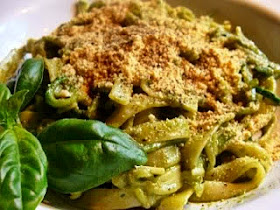Orgran "No Egg" egg replacer meringues with melted vegan chocolate and pecans!
When I went to my local health food store, Edible Island, in Courtenay, BC last week, I spotted an item that was new to the store-- Orgran "No Egg"
One of their recipes caught my eye-- crunchy baked meringues. I decided to give it a try. Not that I ever indulged in them that much as a non-vegan, but many people love them. They are sort of a sweet, blank canvas for fruit, etc, as with the Pavlova, beloved in New Zealand and Australia.
UPDATE: THIS RECIPE WORKS WITH ENER-G EGG REPLACER POWDER!
I wasn't quite sure about the "citrus pectin", but I went to our little local general store to see what they had. All the had was "light pectin" for canning, so I bought a little packet. (After further research, I see that you can buy "modified citrus pectin", but it is very expensive--it seems to be used for everything from the effects of radiation treatment to arthritis-- and the cheap the canning pectin seemed to work!)
It's a simple recipe and is baked pretty much the same way that egg white meringues are baked. The results in their photo looked great, but I wasn't sure what to expect. In any case, I followed their recipe, using my canning pectin. I also wasn't sure what they meant by "pure powdered sugar", but I just used organic powdered sugar.
Here were the results after beating for 10 minutes:
It fluffed up tremendously! It made ALOT of fluff!
After baking them as directed for 2 hours at 250 degrees F, and letting them try out in the turned-off oven with the door cracked open, I was rewarded with 2 trays of lovely, crunchy meringues!
They were airy and crunchy and slightly chewy in the middle, as they should be, but I didn't think they were quite sweet enough. I think I'll use more powdered sugar next time, although there might be a structural reason for using less sugar-- you never know until you try!
We ate them with strawberries on top:
And we ate them with chocolate and pecans:
They kept well and didn't get soft. I'll experiment a bit more and post again. As I said before, it was not something I longed for, and it doesn't contribute anything in the way of nutrition (it is fat-free, though), but meringue is the basis of many beloved desserts, so, it's worth finding a vegan recipe that works even if you only use it on occasion! I want to see if this recipe will work with Ener-G Egg Replacer (UPDATE-- it does!), and I want to use it as the basis of some cookies with coconut, etc..
Al the best!






